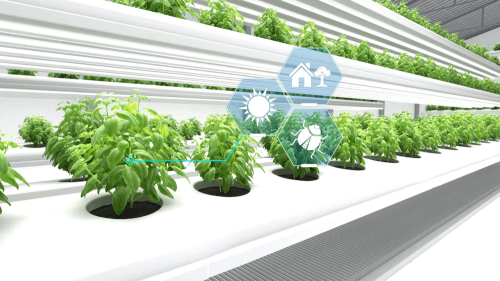
Vertical Farming and Climate Change
Climate change has become one of the greatest global challenges, with deep impacts on ecosystems, agriculture, and living conditions worldwide. Rising temperatures, more frequent droughts, floods, and unpredictable weather patterns are threatening traditional food production methods, reducing arable land, and complicating stable food production. Vertical farming emerges as a potential solution that can significantly contribute to sustainable food production and adaptation to climate change.
The Impact of Climate Change on Traditional Agriculture
Climate change has a profound and far-reaching impact on global agriculture, disrupting the stability of traditional agricultural systems. Rising global temperatures, more frequent droughts, floods, and extreme weather events are altering the conditions for growing crops, reducing yields, and increasing the risks of uncertainty in food production. Additionally, land degradation, loss of biodiversity, and the spread of pests and diseases present further challenges. All of these changes make agriculture more vulnerable, reducing its ability to meet the growing global demand for food. In this context, vertical farming presents a potential solution, as it takes place in controlled environments that are not subject to the impacts of climate change. This approach enables food production in urban areas, regardless of extreme weather conditions, reducing dependence on traditional factors such as weather, rainfall, and soil quality. Vertical farms can continue producing food even when climate change severely affects other forms of agriculture, making them more resilient to adverse conditions and global instability.
Vertical Farming as a Climate-Resilient Solution
Vertical farming, as a method of growing crops in enclosed and controlled environments, offers several advantages in the context of climate change. Key benefits of vertical farming include reduced resource consumption, greater efficiency, and the ability to adapt to changing weather conditions.
Water Conservation
One of the biggest ecological challenges facing agriculture today is the scarcity of water. Agriculture accounts for about 70% of global freshwater consumption, and many regions are experiencing reduced water availability due to climate change. Vertical farming uses significantly less water compared to traditional farming methods. Hydroponic and aeroponic systems, commonly used in vertical farms, recycle water within the system, minimizing waste. By growing plants in closed systems where water is continuously filtered and recycled, vertical farming reduces the need for irrigation and minimizes the ecological impact associated with water consumption. Estimates suggest that vertical farms use up to 90% less water than traditional farms.
Energy Efficiency and Use of Renewable Energy
The energy needs of vertical farms can be significant, particularly in systems that rely on artificial lighting, climate control, and automated management. However, energy consumption in vertical farms can be reduced by integrating renewable energy sources, such as solar or wind power. Vertical farms located in urban areas can use solar panels on rooftops, providing a sustainable energy source and reducing dependence on fossil fuels. Technological advancements have also led to the development of more energy-efficient practices in vertical farming. LED lighting, which is used in vertical farms, consumes significantly less energy than traditional lights and can be tailored to the specific needs of plants for optimal growth. Advanced HVAC (heating, ventilation, and air conditioning) systems further optimize energy consumption by maintaining ideal growing conditions with minimal waste.
Localized Food Production and Reduction of Carbon Footprint
Vertical farming enables localized food production. By placing vertical farms in urban centers or near densely populated areas, the need for long-distance food transportation is reduced, which in turn reduces the overall carbon footprint of food production. Since vertical farms operate in enclosed, controlled environments, they are less dependent on weather changes, providing a more stable and predictable yield, even in regions affected by climate change.
Mitigating Land Degradation and Preserving Biodiversity
A major challenge today is land degradation. Due to the high demand for agricultural land, forests and other natural habitats are being cleared, leading to the loss of biodiversity and exacerbating global warming. In this context, vertical farming can help preserve biodiversity and mitigate these problems by utilizing unused urban spaces, such as rooftops, abandoned industrial warehouses, or vacant lots, for food production. Growing crops in vertically controlled environments uses far less land than traditional farming methods. This reduces the need to clear forests or convert natural areas into agricultural land. Vertical farming systems can be designed to promote biodiversity by growing a variety of plant species in a controlled setting, helping to preserve the genetic diversity of plant species.
Food Security in Changing Climates and Year-Round Availability
Food security is increasingly threatened by climate change, as extreme weather events and changing climate patterns disrupt global food production. Vertical farming can provide a more stable and predictable food supply chain by growing crops in controlled, enclosed environments. These farms are not vulnerable to weather changes, making them less susceptible to floods, droughts, or extreme temperatures.
One of the greatest advantages of vertical farming in an era of increasingly unpredictable climate is the availability of food year-round, without the limitations of seasonal changes. This could be particularly significant in regions where traditional agriculture is becoming less viable due to the impacts of climate change. By ensuring a stable and continuous supply of fresh food, vertical farming can help maintain food security in an uncertain future.
Adopting Vertical Farming for Climate Change Resilience
Vertical farming represents a promising solution to many of the challenges posed by climate change. By reducing water consumption, improving energy efficiency, enabling localized food production, and mitigating land degradation, vertical farming offers a more sustainable and resilient model for agriculture. Although it is not without its challenges, the further development of vertical farming, coupled with supporting policies and investments, could help create a safer and more sustainable global food production system in the face of climate change. As the world confronts the realities of climate change, vertical farming may become a key tool in ensuring a sustainable and resilient future for global food production. Therefore, it is crucial to invest in the growth and expansion of vertical farming systems, as they have the potential to play a central role in addressing the pressing challenges of food security and environmental sustainability.






